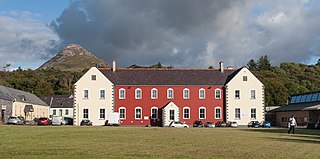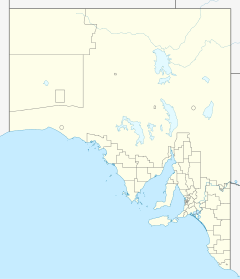
The Don Dale Youth Detention Centre is a facility for juvenile detention in the Northern Territory, Australia, located in Berrimah, east of Darwin. It is a detention centre for male and female juvenile delinquents. The facility is named after Don Dale, a former Member of the Northern Territory Legislative Assembly from 1983 to 1989 and one-time Minister for Correctional Services.

The Port River is part of a tidal estuary located north of the Adelaide city centre in the Australian state of South Australia. It has been used as a shipping channel since the beginning of European settlement of South Australia in 1836, when Colonel Light selected the site to use as a port. Before colonisation, the Port River region and the estuary area were known as Yerta Bulti by the Kaurna people, and used extensively as a source of food and plant materials to fashion artefacts used in daily life.
A reformatory or reformatory school is a youth detention center or an adult correctional facility popular during the late 19th and early 20th centuries in Western countries. In the United Kingdom and United States, they came out of social concerns about cities, poverty, immigration, and gender following industrialization, as well as from a shift in penology to reforming instead of punishing the criminal. They were traditionally single-sex institutions that relied on education, vocational training, and removal from the city. Although their use declined throughout the 20th century, their impact can be seen in practices like the United States' continued implementation of parole and the indeterminate sentence.

Magill is a suburb of Adelaide straddling the City of Burnside and City of Campbelltown council jurisdictions, approximately 7 km east of the Adelaide CBD. It incorporates the suburb previously known as Koongarra Park.

Glandore is a suburb of Adelaide, South Australia, partly in the City of Marion and partly in the City of West Torrens. The name is believed to come from Glandore in County Cork, Ireland, whence the family of John O'Dea, one of the original property owners of the area, came.

Stepney is a small triangular near-city suburb of Adelaide within the City of Norwood Payneham & St Peters. Stepney contains a mix of retail, manufacturing, professional services and distribution outlets within a cosmopolitan population strongly influenced by post World War II immigration.

Sandra Myrtho Kanck is a South Australian politician. She was a member of the South Australian Legislative Council from 1993 to 2009, first elected for the Australian Democrats for an eight-year term at the 1993 election and was re-elected for the Democrats for another eight-year term at the 2002 election. Kanck announced her parliamentary resignation in November 2008, taking effect in January 2009. Democrats nominee David Winderlich filled the upper house casual vacancy in a joint sitting of the Parliament of South Australia in February 2009.

Lytton is an outer riverside suburb in the City of Brisbane, Queensland, Australia. In the 2016 census, Lytton had a population of 6 people.
Edward Picton "Ted" Mullighan, QC was an Australian judge who was known as an Indigenous rights advocate and protecting vulnerable people. He was known for his role as Commissioner of the Government of South Australia' Children in State Care Commission of Inquiry from 2004 to 2008.

Somerton Park is a seaside suburb of Adelaide in South Australia. The mainly residential suburb is home to the Somerton Park Beach, Sacred Heart College and North Brighton Cemetery.

Industrial schools were established in Ireland under the Industrial Schools (Ireland) Act 1868 to care for "neglected, orphaned and abandoned children". By 1884, there were 5,049 children in such institutions throughout the country. The Act was superseded by the Children Act 1908.

North Adelaide is a predominantly residential precinct and suburb of the City of Adelaide in South Australia, situated north of the River Torrens and within the Adelaide Park Lands. Laid out in a grid plan in three sections by Colonel William Light in 1837, the suburb contains many grand old mansions.
Francis Robert Burton was a Public Servant in the early days of South Australia and is remembered for his work in improving penal treatment of delinquent boys.

Kate Cocks was a welfare worker and one of two of the state's first female police officers in South Australia. She is best known for her work with unmarried mothers and their babies. The Kate Cocks Memorial Babies Home named after her in honor of her work.
Kurlana Tapa Youth Justice Centre is a youth detention centre at two campuses in Cavan, an industrial northern suburb of Adelaide, South Australia. It is operated by the Government of South Australia Department of Human Services, unlike adult prisons which are operated by the Department for Correctional Services. It is the only dedicated youth detention centre in South Australia.
Edward Francis Troy was a stained glass artist and decorative painter in Adelaide, South Australia, and a founder, in 1884, of the St Vincent de Paul Society in that State.

The Destitute Asylum was a government-funded institution in Adelaide in the colony of South Australia, designed to support those of its citizens who had no means of financial support, especially new arrivals and mothers with children. It was first established around 1839 as a Native School, with boarding facilities, for teaching local Aboriginal children, and functioned for some years in this capacity. As the school was not fully supported and therefore under-utilised, it started being used for young women arriving in the colony on their own, sometimes as orphans, and around 1850 became the Destitute Asylum. By 1855 it was holding both males and females, many of whom had been transferred for convalescence from the Adelaide Hospital.
The Westbrook Reformatory for Boys was a reformatory school in the town of Westbrook, in the Toowoomba Region, Queensland, in Australia. The Westbrook Reformatory was created in 1900 after the closure of earlier versions of the institution on the former prison hulk, the Proserpine, and at Lytton, Queensland. The Reformatory changed its name to the Westbrook Farm Home for Boys in 1919. Under this later name, it was the subject of a major scandal which culminated in a government inquiry. The institution was renamed twice more before its closure in 1994. Since its closure, the Westbrook institution has become known as a site of serious institutional abuse. It was described at length in the 1999 Forde Inquiry and the 2004 Forgotten Australians report.
Biloela Industrial School for Girls (1871–1887) was a 19th-century Australian girls' school, situated on Cockatoo Island, New South Wales. Although officially termed an industrial school, it was just as much a reformatory as those located at Coburg or Magill, with this difference, that those girls found in brothels and on the street were sent to Biloela, while criminal girls were committed to Shaftesbury Reformatory for Girls, while Coburg and Magill received both classes. The girls arrived in 1871, having been transferred from Newcastle Industrial School for Girls. In 1887, the girls were transferred once again, this time to more suitable buildings at Parramatta, that being the Parramatta Girls Industrial School.












